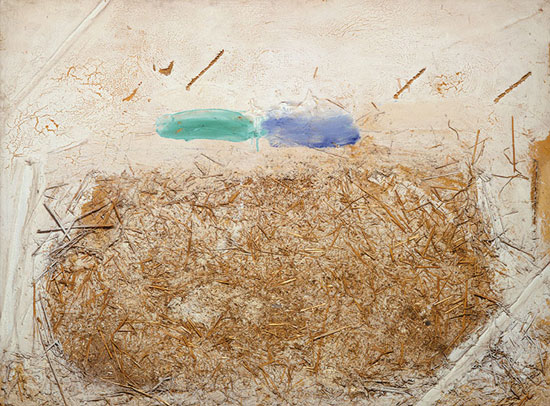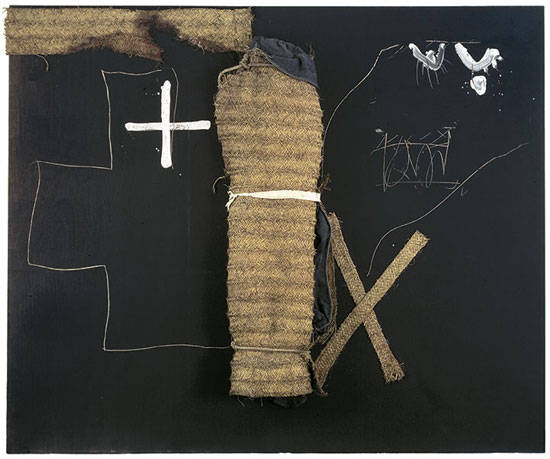Art by Antoni Tàpies is stained by memories of rubble-strewn streets of the Spanish Civil War and World War II. It's scarred by defiance to the 36 years of Spain's totalitarian Franco regime, from 1939 to 1975. Given this legacy, his art now on view at Pérez Art Museum Miami in "Tàpies: From Within" isn't easy to confront. His abstractions are curdled with gritty resistance to the status quo.
Tàpies (1923-2012) made tough art reflecting tough times, eschewing anything that smacked of the precious and pretty. Marble, a prized medium for sculpture and architecture since antiquity, was a material he like to use when it was ground to dust, bereft of grandeur. It's transformed into powdery particles surfacing only in drab-colored art as silvery sparkles. That is, if the work is lighted properly and the viewer’s head is tilted at the right angle to see it.
Marble dust became just one of his many "poor materials," including earth, sand, string, rags and scribblings reminiscent of urban walls of graffiti blaring virulent protest. In the early 1950s, Tàpies developed his signature style of "matter paintings," working with down-to-earth materials. His style is often linked to Art Informel or "unformed art," a European variation during the rise of Abstract Expressionism.
The artist's name means "walls" in Spanish. His canvases often display the messy, gouged surface of exterior urban walls, reflecting Spanish postwar life darkened by fears fostered by Franco and the Atomic Age. Yet other symbols and elements recur throughout, referring to vulnerable human figures and landscape, endowing his art with tenderness and spiritual simplicity—in mighty contrast to all those gritty surfaces.
Street Graffiti Witnessed Repression
As Tàpies wrote in a 1969 essay published in Barcelona, "my first works of 1945 had something to do with street graffiti and a universe of repressed protest, clandestine yet full of life, as one could find on the walls of my country." In that same essay, he noted that city walls "witnessed the martyrdom and the inhumane repression inflicted on our people."
This rebellious, erudite, and primarily self-taught artist became one of Spain's most celebrated. PAMM is the only U.S. venue for this historical survey, "Tàpies: From Within," comprising 50 works and drawn from the larger survey presented a year after his death at Fundació Antoni Tàpies and Museu Nacional d'Art de Catalunya in the artist's hometown of Barcelona. That larger survey was curated by Vicente Todolí, former director of London's Tate Modern and now artistic director of Hangar Bicocca, a contemporary art museum in Milan.
Concurrent with the PAMM exhibit is "Antoni Tàpies 1923-2012," through March 21, at New York's Pace Gallery, which has represented this artist since the early 1990s. This is the first New York exhibit since his death in 2012.
Many Honors
It's possible to see these shows, marble dust and all, as a grand goodbye to Tàpies. Among his many honors: He represented Spain, along with Eduardo Chillida, at the 1958 Venice Biennale. He had a solo show at the Solomon R. Guggenheim Museum four years later. In 1993, he again represented Spain at the Venice Biennale, winning the Golden Lion prize. Retrospective exhibits were mounted at Jeu de Paume in Paris in 1994 and Madrid's Reina Sofía Museum in 2000.
In 1984 Tàpies established his foundation, which hosts symposia and one of the largest collections of the artist's work, prompting the posthumous exhibits in Barcelona and Miami culled from his own collection and foundation. These shows offer an "inside look" at work the artist held dear and kept for himself—hence the title, "From Within."
PAMM's chief curator, Tobias Ostrander, collaborated with Todolí to select 50 works from the Barcelona exhibits for PAMM. Additionally, Ostrander curated "Waste After Waste," an installation by Diego Bianchi, aiming to highlight how the Tàpies legacy informs art produced today. Bianchi's installation, inspired by rapid consumption and instant obsolescence of items like cell phones and sunglasses, incorporates discarded objects recovered around Miami.
"I see a lot of artists thinking about materials again," said Ostrander during the February 4 press tour of "Tàpies: From Within."
"We live in an increasingly digital era," the curator added, suggesting paradoxically that digital innovations transforming our 24/7 life render the materiality of Tàpies particularly relevant now, noting that some contemporary artists are especially interested in "the surface of the canvas."
Drawing on the artist’s work from 1945 to 2009, PAMM's exhibit gives a judicious sense of his career. Much of the work is primarily abstract, with fleeting reminders of the human figure and landscape, as well as references to Christianity and Eastern philosophy.
Spiritual Sensibilities
Cruciform shapes, surely recalling the geometric modernism of Mondrian as well as the intensely bloody Catholic crucifix in Spanish churches, appear throughout. An artist of wide-ranging, spiritual sensibilities, Tàpies wrote in a 1999 essay published in Madrid about his interest in Eastern philosophy as well as "Eucharistic images … the wondrous symbolic ingestion of God."
His tough, contemplative art is a welcome antidote to the present, when the commodification of art spirals to an ever grander global reach, thanks to digital marketing and the proliferation of art fairs.
Home (Man) and Composició amb figures (Composition with Figures), both from 1945, are perhaps the two most figurative works in the exhibit. These paintings loosely portray people radiating celestial light in abstract, atmospheric space suggesting a blue sky or green fields.
.

"Composició ambfigures (Composition with Figures)" by Antoni Tàpies, 1945. Oil on canvas, 24 x 24 inches. Fundació Antoni Tàpies, © Fundació Antoni Tàpies/VEGAP, 2013.
.
Verd-blau palla (Green-Blue Straw, 1968) is clearly an abstract composition, created from mixed media on wood. And yet, in the context of this exhibit, the brief slashes of blue and green hovering above an earthy mass of crushed straw suggest shorthand references to the human figures surrounded by landscape in those 1945 paintings.
.

"Verd-blau palla (Green-Blue Straw)" by Antoni Tàpies, 1968. Mixed media on wood, 35 x 46 inches. Fundació Antoni Tàpies, © Fundació Antoni Tàpies/VEGAP, 2013.
.
References to the human figure persist in later works that may seem, at first glance, wholly abstract, as in Materia rosada (Pink Material, mixed media on canvas, 1991). Stepping back from this work to take in its general, flesh-toned forms, the viewer may discern a human foot and bent leg, perhaps belonging to a Christ-like figure stumbling under the weight of a cross, which appears to be represented by a thick band of pink. That all this "pink material" is placed within a forbidding, dark space makes it an especially vivid allusion to human suffering and the spiritual longing for deliverance from earthly abuse.
.

"Matèria rosada (Pink Material)' by Antoni Tàpies, 1991. Mixed media on canvas, 88 x 86 inches. Fundació Antoni Tàpies, © Fundació Antoni Tàpies/VEGAP, 2013.
.
A subtle evocation of Christ shrouded for burial energizes cruciform shapes layered within Embolcall (Wrapping, mixed media assemblage, 1994). Central to this composition is a vertical wrapped form suggesting the Shroud of Turin.
.

"Embolcall (Wrapping)" by Antoni Tàpies, 1994. Mixed media and assemblage on wood, 98 x 118 inches. Fundació Antoni Tàpies, © Fundació Antoni Tàpies/VEGAP, 2013.
.
Grace, Gutsy Poetry
Cadira i roba (Chair and Clothes), a sculptural object from 1970, illustrates the artist's fondness for highly tactile and humble, three-dimensional materials scavenged from daily life, while dramatically evoking the human figure—or rather, the absence of the human figure.
The piece is composed of a simple wooden chair draped messily with worn clothes and a towel that could even be read as another example of "pink material." These materials occupy the chair almost the way a person would and would need to be moved before anyone could sit in the chair. With casual but deliberate grace, Tàpies once again makes chiefly abstract shapes evoke humanity at its most humble and direct.
.

"Cadira i roba (Chair and Clothes)" by Antoni Tàpies, 1970. Object assemblage, 37 x 30 x 25 inches. Fundació Antoni Tàpies, © Fundació Antoni Tàpies/VEGAP, 2013.
.
Late in his career, Tàpies was still inspired by 1945 memories of street graffiti. A dense thicket of looping black lines looks for all the world like a wall scribbled with angry graffiti in Sóc terra (I Am Earth, 2004). For all his worldly renown, Tàpies still infused abstraction with the gutsy poetry of Spanish protest.
.

"Sóc terra (I Am Earth)" by Antoni Tàpies, 2004. Mixed media on canvas, 69 x 79 inches. Fundació Antoni Tàpies, © Fundació Antoni Tàpies/VEGAP, 2013.
.
____________________
BASIC FACTS: "Tàpies: From Within" continues through May 3, 2015 at Pérez Art Museum Miami, 1103 Biscayne Blvd., Miami FL 33132. www.pamm.org.
In New York City, Tàpies's work can be seen in "Antoni Tàpies: 1923 - 2012" through March 21, 2015 at Pace Gallery, 32 East 57th Street, New York, NY 10022. www.pacegallery.com.
_____________________
Copyright 2015 Hamptons Art Hub LLC. All rights reserved.
